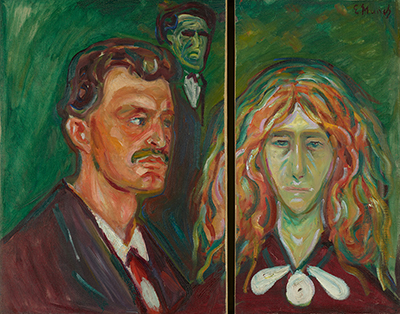Caricature Portrait of Tulla Larsen by Edvard Munch was painted in oil on canvas in 1905. The painting is a self-portrait of Munch with Larsen, his former fiancée, and was later torn in half by the artist following a lover's tiff, where Munch was accidentally shot in the left hand.
The half of the painting depicting Munch was later known in isolation as Self-Portrait Against a Green Background. However, the two sides of the painting have now been reunited and are part of the collection housed in the Munch Museum, Oslo. Painted by Munch as their relationship had begun to sour, Caricature Portrait of Tulla Larsen shows Munch and Larsen looking dour and disconnected, the artist glaring at his fiancée in red-faced defiance, whilst she faces forwards, her glassy stare looking out towards the unknown viewer. A spectre of a third figure, who looks rather like Munch, hovers ominously in the background. Women are often the subject matters of much of Edvard Munch's work, and to say his relationship with the opposite sex was complicated would be an understatement.
However, despite the swirling green tumultuous background that surrounds Munch and Larsen, it is clear that Larsen is still the star of the piece. Her hair is a myriad of reds and oranges, streaked with green, and her unflinching stare pulls the eye of the viewer into the painting, her distinct white collar standing out against her burgundy dress. Despite their clearly difficult relationship, Munch still cannot turn away from her, even in anger, and the ghost that hovers behind them watches her too, as if Munch's physical and mental form are both tied to Larsen. The palpable anxiety of the painting echoes much of Munch's other works, including arguable his most famous work, The Scream.
The paintings of Norwegian artist Edvard Munch are most synonymous with Symbolism and Expressionism, and Caricature Portrait of Tulla Larsen is clearly Expressionist in its construction, with the emotional resonance of the subject matter more important than the actual reality. The two sides of Caricature Portrait of Tulla Larsen were retained by Edvard Munch's estate, and even now the two sides of the painting are united together again, the physical division makes the artwork even more powerful. It gives the work added emotional resonance and shows that even though physically separated, mentally the couple are still very much bound together in an evocative and disturbing way.




